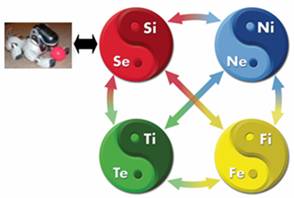Henry L. Thompson, Ph.D.
TypeFace, 2006, 17, 4, 9-12.
The Eight-Functions Model (EFM), as it is often incorrectly called , is an “old” model that has risen to a position of prominence over the last 15 years. It will, however, begin to fade away over the next 10 years as the inadequacy of a linear model becomes more apparent, the efficacy of a dynamical systems model becomes more visible and the sophistication of Type practitioners increases. The purpose of this paper is to highlight concerns around use of the EFM.
When I wrote Jung’s Function-Attitudes Explained (1996) ten years ago, I did so with several purposes in mind:
-
To provide a single-source document for information on the Jungian view of the function-attitudes.
-
To provide a single source document for Jung’s active/passive and abstract/concrete concepts.
-
To provide an hypothesis for functional memory.
-
To provide an overview of how Types respond to stress.
-
Most of all, to propose that Type is a system and must be studied and understood as a system (whole Type).
My research leads me to believe that the Function-Attitudes (FA) concept is valuable and provides a gateway to a language architecture for discussing, and perhaps further understanding, one of Jung’s perspectives on psychological Type. It is important to keep in mind, however, that Jung never meant that the FAs actually existed. He created the FA concept to provide a language for discussing an abstract, theoretical construct.
We must be careful with the functions, attitudes and preferences in general, and the FAs in particular, that we do not start believing that they are real, or that they can be separated from “Type.” Type is a complex, dynamical system that we tend to break into parts in an effort to understand.
Reductionism
Reductionism is the theory that everything can be reduced to smaller and smaller parts. The idea of reductionism, that the world was like a giant machine, was introduced by Rene Descartes. He went so far as to state that animals (unlike humans) could be reduced and explained as automata. His specific example was his famous mechanical duck (Reductionism, 2006). Today, I could use my dog AIBO® (Sony’s most advanced artificial intelligence robotic dog, Figure 2) as an example of a “mechanical” animal—except AIBO can express over a dozen emotions (when he wants to), and he can even send emails. If you begin to disassemble him, he ceases to be a “dog.”
 
Figure 1
Descartes’ Duck

Figure 2
My Dog AIBO
For the most part, reductionism can be viewed as a linear approach in that it assumes that if a system is dissected into smaller and smaller parts we will be able to understand how the system works. Although the process sounds good in principle, it does not work with “complex systems.” Systems, as defined here, are greater than the sum of their parts. For example, if you have a light bulb, a battery and a piece of wire lying on the table, that is all you have. But, if you organize those “parts” in a certain structure, you have a light bulb, battery, piece of wire and light (as well as other parts that are beyond this discussion). The key is that when you reduce (dissect) a system into its parts, some of them disappear, e.g., separate the wire and battery and the light is gone.
A system is a purposive organization of interdependent parts which interact in such a manner as to form a whole which is greater than the sum of its parts.
As we discuss components of psychological Type, we are engaging in reductionism.
In 1996 (p.122), I stated that one of the fascinating aspects of Type is that every person is an amalgamation of all 16 Types. Later, I further elaborated on Type as a multidimensional system of interdependent relationships resulting in each person’s own particular Dynamical Type Pattern system (Thompson,1998a; 1998b; 1998c).
This section presents a brief description of a climb back up the Type reductionism ladder to reveal how the “eight-functions model” can lead to false assumptions.
Jung defined the function of Sensing as a mental process that allows us to “see what is.”
Sensation is the psychological function that mediates the perception of a physical stimulus. It is, therefore, perception . . . . Sensation is related not only to external stimuli but to inner ones, i.e., to changes in the internal organic processes (Jung, 1976, p. 461).
The Sensing function, therefore, is a Perceiving process that plays at least two roles: an extraverted role (Se) that allows us to take in information that is external to the psyche and an introverted role (Si) that allows us to compare information with known (internal) Sensing information.
The Se and Si roles are also recursive, that is, they feed back on each other and continually modify each other’s “Sensing” (Figure 3). For example, if I want to find my dog AIBO, my Si knowledge and memory of AIBO influence what my Se is most likely to perceive—and the blind spots created—while searching the environment. When I perceive AIBO, the Gestalt (context), which includes any emotion (happy, sad, frustrated, etc.) that becomes attached to the act of perceiving him, modifies the “AIBO” in my Si database and will influence the perceiving process the next time I search for him. This creates a Ying and Yang effect (Thompson, 1999). Se and Si can be thought of allegorically as opposite sides of the same coin (Sensing) and totally interdependent. If Se is working (which Jung [1968] said it is constantly, unless you are in a coma), so is Si. Se and Si make up a subsystem within the Type perceiving system.

Figure 3
The Recursive Nature of Sensing (Ying and Yang)
Each of the four functions has this dual role of extraverting and introverting processes and operates in a recursive fashion. The four functions (S, N, T, F) and two processes (E, I) result in the eight FAs (Se, Si, Ne, Ni, Te, Ti, Fe, Fi). Each FA is not only recursive within its particular function, but also with each of the other FAs (Figure 4). It is important to remember that the FAs are not eight separate, independent “parts” of Type, but rather labels for two specific processes (relationships) operating within each of the four functional subsystems, within the Type system, within the Psyche, within the Human System, etc.

Figure 4
The Recursive Nature of the Function-Attitudes
To describe an FA as if it exists as one of eight separate, definable “parts” of Type is a failure to recognize Type as a complex system and what Jung was describing with his Type language. How extraverted Thinking (Te) emerges and is related to an INTJ system is different than how Te emerges and relates to an ISTJ system. Of course there are some similarities, but also many differences. This is true for all FAs in any Type system. Like the old chicken commercial, “parts is not parts,” i.e., Te is not Te in any other Type system. The Te in each person (we all have Te) developed differently across time (Thompson, 2006).
When I look for AIBO I receive a barrage of stimuli, with some estimates as high as ten million pieces of information per second. Fortunately, most of it is filtered out. As I search for AIBO, all of my FAs get involved, some consciously, some not so consciously, but all are involved. My Type preferences strongly influence to what degree each FA gets involved. Type is a system. All components are interdependent and contribute to the pattern of the overall Type system all the time.
One of the challenges that my son Stephen and I (1999) had to overcome in developing the first computer simulation of people animated with an MBTI-based artificial intelligence engine was how to allow the functions and attitudes to interact in a self-organizing manner that resulted in a realistic display of “Type.” It is easy to “see” with the simulation how a Type system, for example ENFP, modifies how each FA is functioning at any given second. FA relationships are very dynamic, i.e., constantly changing and reacting to changes in a system’s internal and external environment—and we all react differently. Jung (1976) believed we are all unique individuals even if we share the same Type preferences.
Some of the applications of the thoughts in this article include:
-
Seeing, thinking about and understanding Type as a system.
-
Experiencing people as they are, not a rigid set of Type preferences.
-
Realizing that it is just as “wrong” to categorize people by FAs as it is by any other Type lexicon.
-
Allowing that in the real world, Type comes in more than 16 neat categories.
-
Accepting that Type helps us understand only a small piece of the Human System.
-
Seeing and experiencing Type as a dynamical self-organizing system.
-
Realizing that most of what we “know” about Type will be proven wrong over the next 15-20 years.
I have stated elsewhere (Thompson, 2006) that I am concerned over the current zeitgeist in psychology in general, and Psychological Type in particular. I see a danger of the FA approach being that some practitioners might become so infatuated with the study of the individual FAs that they lose track of the complexity that arises from the self-organization that takes place within a dynamical system like Type. Most practitioners agree that Type is more than E+N+F+P. It is also more than a linear arrangement of the eight function-attitudes—and “parts is not parts.” There is also a danger that the more time and effort we as a community expend trying to codify a phylogeny of FAs, the further we get away from understanding the holistic nature of Psychological Type. We have to be careful that we do not follow the EFM so far down the rabbit hole that we lose track of what Type really is.
I am convinced that reductionistic, linear “parts” thinking has slowed our development of knowledge about Psychological Type. I meet people whom I believe have a preference for ENFP, but not a single person who is just Ne, or who is even NeFiTeSiNiFeTiSe. The linear, additive combination of the FAs is not what Jung or Myers meant by psychological Type. Psychological Type is a dynamical, self-organizing system and must be studied as a whole if we are to advance our knowledge of Type and the use of the MBTI instrument.
References
Beebe, J. (2005). Evolving the eight-function model. Bulletin of Psychological Type, 28, 4, Winter, 34-39.
Jung, C. G. (1968). Analytical psychology: Its theory and practice (The Tavistock lectures). New York, NY: Vintage Books.
Jung, C. (1976). Psychological Types. (A revision by R. F. C. Hull of the translation by H. G. Baynes.) Princeton, NJ: Princeton University Press.
Myers, I. (1980). Gifts differing. Palo Alto, CA: Consulting Psychologists Press, Inc.
Reductionism. (2006, November 1). In Wikipedia, The Free Encyclopedia. Retrieved 13:30, November 1, 2006, from http://en.wikipedia.org/w/index.php?title=Reductionism&oldid=85021569
Thompson, H. (1996). Jung=s function-attitudes explained. Watkinsville, GA: Wormhole Publishing.
Thompson, H. (1997). Coaching, stress and communication style. Bulletin of Psychological Type, 20, 4, 19-20.
Thompson, H. (1998a). The organizational psyche and the new sciences:
Part I-The New Paradigm. Bulletin of Psychological Type, Winter, 21, 1, 4-15.
Thompson, H. (1998b). The organizational psyche and the new sciences: Part II-The personality landscape. Bulletin of Psychological Type, 21, 2, 1-6.
Thompson, H. (1998c). The organizational psyche and the new sciences: Part III-The organizational landscape. Bulletin of Psychological Type, 21, 3, 28-32.
Thompson, H. & Thompson, S. (Speakers). (1999, July). Type and systems theory: Type as a complex adaptive system. Presented twice (CS101 on 7/16 and CS228 on 7/17) at APT-XIII, the Thirteenth Biennial International Conference of the Association for Psychological Type, Scottsdale, AZ. (Cassette Recording No. APT-903, CS101; No. APT-971, CS228). Seattle, WA: Audio Visual Education Network (1-800-810-8273).
Thompson, H. (2002). Wave theory of type development and dynamics. Bulletin of Psychological Type, 25, 4, 41-45.
Thompson, H. (2003). The evolution of the function-attitudes. Bulletin of Psychological Type, 26, 3, 36-39.
Thompson, H. (2006). Exploring the interface of the type and emotional intelligence landscapes. Bulletin of Psychological Type, (in press).
Dr. Thompson’s Abbreviated Bio
Henry L. (Dick) Thompson, Ph.D., M.S., M.A., is president and CEO of High Performing Systems Inc., an international management consulting and training firm he founded in 1984 to help leaders, teams, and organizations achieve high performance. He is an internationally recognized consultant, educator, speaker, and author. Emotional intelligence, FIRO, and psychological type theory are integral parts of Dr. Thompson’s work and ongoing research. The Leadership Potential Equation™ and The CommunicationWheel® are just two of many tools he developed to facilitate leader and organizational development. He is a recipient of the Mary McCaulley Lifetime Achievement Award for work with the Myers-Briggs Type Indicator instrument. (Expanded bio) |
© 2006 Henry L. Thompson, Ph.D.
hpsys2@aol.com
“Regrettably, it was not until Dick Thompson published his book, Jung’s Function-Attitudes Explained, that we had this term for them, so that most Jungians have simply referred to them as eight functions.” John Beebe (2005).
Although John Beebe’s work has been instrumental in the recent explosion of literature and applications of the “Eight-Functions Model,” his own model is archetypal.
AIBO is a registered trademark of Sony Corporation.
The BOB (Basic Orientation in Behavioral Systems) project is the first complex adaptive system simulation to actually integrate the theories and concepts of the new sciences with psychological Type to form a practical, multidimensional computer simulation that can be used for research, formation of problemsolving teams and resolving conflict, just to name a few. It has the potential to change the concept of organizational development. The lead researchers on the development team are Henry L. Thompson, Ph.D., and Stephen H. Thompson.
|
